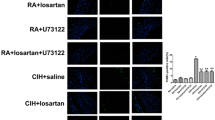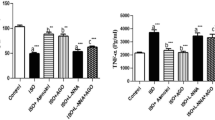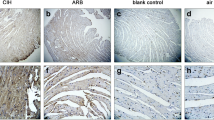Abstract
Purpose
NO and NO synthase (NOS) are known to play key roles in the development of myocardial apoptosis induced by ischemia/hypoxia. Current evidence suggests that angiotensin II type 1 receptor blockers, such as telmisartan, lower blood pressure and produce beneficial regulatory effects on NO and NOS. Here, we examined the protective role of telmisartan in myocardial apoptosis induced by chronic intermittent hypoxia (CIH).
Methods
Adult male Sprague–Dawley rats were subjected to 8 h of intermittent hypoxia/day, with/without telmisartan for 8 weeks. Myocardial apoptosis, NO and NOS activity, and levels of inflammatory mediators and radical oxygen species were determined.
Results
Treatment with telmisartan preserved endothelial NOS expression and inhibited inducible NOS and excessive NO generation, while reducing oxidation/nitration stress and inflammatory responses. Administration of telmisartan before CIH significantly ameliorated the CIH-induced myocardial apoptosis.
Conclusions
This study show that pre-CIH telmisartan administration ameliorated myocardial injury following CIH by attenuating CIH-induced myocardial apoptosis via regulation of NOS activity and inhibition of excessive NO generation, oxidation/nitration stress, and inflammatory responses.




Similar content being viewed by others
References
Peppard PE, Young T, Palta M, Skatrud J (2000) Prospective study of the association between sleep-disordered breathing and hypertension. N Engl J Med 342:1378–1384
Gottlieb DJ, Yenokyan G, Newman AB, O’Connor GT, Punjabi NM, Quan SF et al (2010) Prospective study of obstructive sleep apnea and incident coronary heart disease and heart failure: the sleep heart health study. Circulation 122:352–360
Chen L, Zhang J, Hu X, Philipson KD, Scharf SM (2010) The Na+/Ca2+ exchanger-1 mediates left ventricular dysfunction in mice with chronic intermittent hypoxia. J Appl Physiol 109:1675–1685, 1985
Ding W, Zhang X, Huang H, Ding N, Zhang S, Hutchinson SZ et al (2014) Adiponectin protects rat myocardium against chronic intermittent hypoxia-induced injury via inhibition of endoplasmic reticulum stress. PLoS One 9:e94545
Cespuglio R, Amrouni D, Meiller A, Buguet A, Gautier-Sauvigne S (2012) Nitric oxide in the regulation of the sleep-wake states. Sleep Med Rev 16:265–279
Forstermann U, Sessa WC (2012) Nitric oxide synthases: regulation and function. Eur Heart J 33:829–837, 837a
Carnicer R, Crabtree MJ, Sivakumaran V, Casadei B, Kass DA (2013) Nitric oxide synthases in heart failure. Antioxid Redox Signal 18:1078–1099
Yamamoto K, Ohishi M, Ho C, Kurtz TW, Rakugi H (2009) Telmisartan-induced inhibition of vascular cell proliferation beyond angiotensin receptor blockade and peroxisome proliferator-activated receptor-gamma activation. Hypertension 54:1353–1359
Li L, Luo Z, Yu H, Feng X, Wang P, Chen J et al (2013) Telmisartan improves insulin resistance of skeletal muscle through peroxisome proliferator-activated receptor-delta activation. Diabetes 62:762–774
Yuen CY, Wong WT, Tian XY, Wong SL, Lau CW, Yu J et al (2011) Telmisartan inhibits vasoconstriction via PPARgamma-dependent expression and activation of endothelial nitric oxide synthase. Cardiovasc Res 90:122–129
Rinaldi B, Di Filippo C, Capuano A, Donniacuo M, Sodano L, Ferraraccio F et al (2012) Adiponectin elevation by telmisartan ameliorates ischaemic myocardium in Zucker diabetic fatty rats with metabolic syndrome. Diab Obesity Metab 14:320–328
Hui-guo L, Kui L, Yan-ning Z, Yong-jian X (2010) Apocynin attenuate spatial learning deficits and oxidative responses to intermittent hypoxia. Sleep Med 11:205–212
Del RR, Moya EA, Parga MJ, Madrid C, Iturriaga R (2012) Carotid body inflammation and cardiorespiratory alterations in intermittent hypoxia. Eur Respir J 39:1492–1500
Gudi T, Hong GK, Vaandrager AB, Lohmann SM, Pilz RB (1999) Nitric oxide and cGMP regulate gene expression in neuronal and glial cells by activating type II cGMP-dependent protein kinase. Faseb J 13:2143–2152
Li CQ, Wogan GN (2005) Nitric oxide as a modulator of apoptosis. Cancer Lett 226:1–15
Xu KY, Huso DL, Dawson TM, Bredt DS, Becker LC (1999) Nitric oxide synthase in cardiac sarcoplasmic reticulum. Proc Natl Acad Sci U S A 96:657–662
Massion PB, Feron O, Dessy C, Balligand JL (2003) Nitric oxide and cardiac function: ten years after, and continuing. Circ Res 93:388–398
Walford G, Loscalzo J (2003) Nitric oxide in vascular biology. J Thromb Haemost 1:2112–2118
Damy T, Ratajczak P, Robidel E, Bendall JK, Oliviero P, Boczkowski J et al (2003) Up-regulation of cardiac nitric oxide synthase 1-derived nitric oxide after myocardial infarction in senescent rats. Faseb J 17:1934–1936
Gonon AT, Bulhak A, Labruto F, Sjoquist PO, Pernow J (2007) Cardioprotection mediated by rosiglitazone, a peroxisome proliferator-activated receptor gamma ligand, in relation to nitric oxide. Basic Res Card 102:80–89
Ye Y, Lin Y, Manickavasagam S, Perez-Polo JR, Tieu BC, Birnbaum Y (2008) Pioglitazone protects the myocardium against ischemia-reperfusion injury in eNOS and iNOS knockout mice. Am J Physiol Heart Circ Physiol 295:H2436–H2446
Frantz S, Adamek A, Fraccarollo D, Tillmanns J, Widder JD, Dienesch C et al (2009) The eNOS enhancer AVE 9488: a novel cardioprotectant against ischemia reperfusion injury. Basic Res Card 104:773–779
Mungrue IN, Gros R, You X, Pirani A, Azad A, Csont T et al (2002) Cardiomyocyte overexpression of iNOS in mice results in peroxynitrite generation, heart block, and sudden death. J Clin Invest 109:735–743
Fu Y, Wang Z, Chen WL, Moore PK, Zhu YZ (2007) Cardioprotective effects of nitric oxide-aspirin in myocardial ischemia-reperfused rats. Am J Physiol Heart Circ Physiol 293:H1545–H1552
Ing DJ, Zang J, Dzau VJ, Webster KA, Bishopric NH (1999) Modulation of cytokine-induced cardiac myocyte apoptosis by nitric oxide, Bak, and Bcl-x. Circ Res 84:21–33
Lee JH, Yang ES, Park JW (2003) Inactivation of NADP+-dependent isocitrate dehydrogenase by peroxynitrite. Implications for cytotoxicity and alcohol-induced liver injury. J Biol Chem 278:51360–51371
Papademetriou V (2009) Inhibition of the renin-angiotensin-aldosterone system to prevent ischemic and atherothrombotic events. Am Heart J 157:S24–S30
Saavedra JM, Sanchez-Lemus E, Benicky J (2011) Blockade of brain angiotensin II AT1 receptors ameliorates stress, anxiety, brain inflammation and ischemia: therapeutic implications. Psychoneuroendocrinology 36:1–18
Michel MC, Foster C, Brunner HR, Liu L (2013) A systematic comparison of the properties of clinically used angiotensin II type 1 receptor antagonists. Pharmacol Rev 65:809–848
Acknowledgments
This study was funded by the National Natural Science Foundation of PR China (grants 81370185 and 81070067).
Author information
Authors and Affiliations
Corresponding author
Rights and permissions
About this article
Cite this article
Yuan, X., Zhu, D., Guo, Xl. et al. Telmisartan attenuates myocardial apoptosis induced by chronic intermittent hypoxia in rats: modulation of nitric oxide metabolism and inflammatory mediators. Sleep Breath 19, 703–709 (2015). https://doi.org/10.1007/s11325-014-1081-y
Received:
Revised:
Accepted:
Published:
Issue Date:
DOI: https://doi.org/10.1007/s11325-014-1081-y




